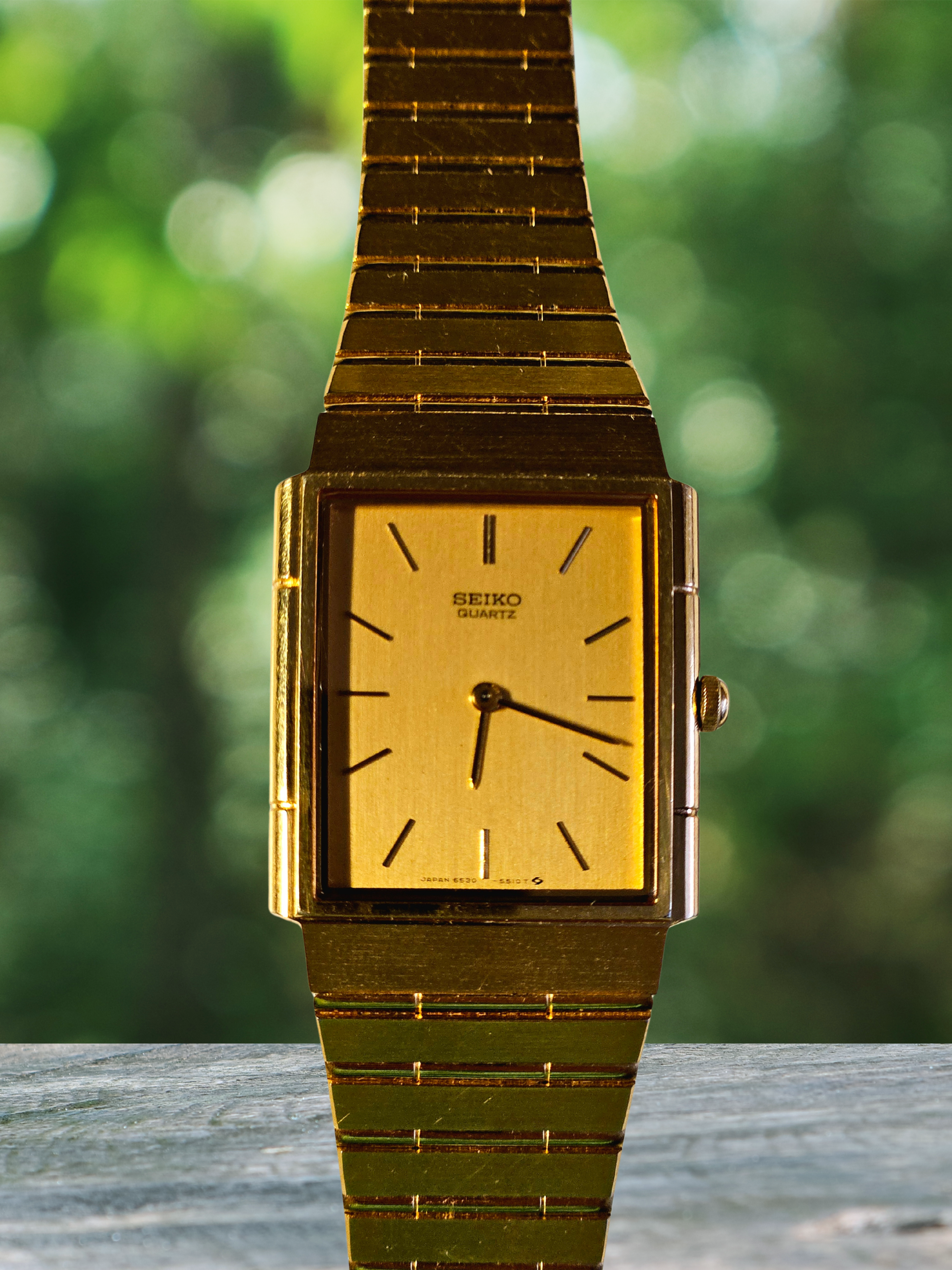
Seiko Quartz - SQ 6530
Always one step ahead of the rest.
E£11500.00
Out of stock
When Quartz Met Elegance — The Story of the Seiko 6530
In the early 1980s, the world of horology was still adjusting after the shockwaves of the Quartz Crisis. Mechanical stalwarts were scrambling; newcomers were pushing boundaries. It was in this era, around 1982, that Seiko introduced the 6530 quartz calibre. Mizeni
The 6530 was neither a flagship chronometer movement nor a showpiece of hyper-technology. Rather, it was part of Seiko’s quiet expansion of its quartz lines — reliable, precise, and made to serve the everyday watch. It carried the weight of Seiko’s quartz legacy (which began in earnest with the Astron in 1969) while also representing how far the brand could stretch quartz into refined territory. Wikipedia+1
I imagine a collector’s gaze lingering on a 6530-based watch: the clean lines, the thinness, the whisper of ticking that says, “I run clean, I run true.” It’s not a movement that steals glances — but one that draws appreciation from those who listen carefully.
Specs & Anatomy of the 6530
Let's anchor ourselves in what is known. The Seiko calibre 6530 is an analog quartz movement with these documented traits: Mizeni
Feature | Specification |
|---|---|
Type | Quartz, analog |
Year / Production Start | ~ 1982 onward Mizeni+1 |
Battery | SR920SW / 371 silver-oxide cell Mizeni |
Accuracy | ±15 seconds/month Mizeni |
Jewels | 5 jewels Mizeni |
Rate / Frequency | 32,768 Hz (standard quartz frequency) Mizeni |
Dimensions | Diameter ~23.3 mm / Height ~2.3 mm Mizeni |
Complications | Time only — hours, minutes, seconds; no day/date or chronograph Mizeni+1 |
Origin / Division | Suwa (Nagano) development division Mizeni |
One example model is the Seiko 6530-5080 (and variants) which uses this calibre. theseikoguy.com Also, the 6530-5270 is another variant tied to this movement. theseikoguy.com
In terms of real-world examples, many 6530 watches show up in vintage dress styles — thin, modest cases, elegant proportions, minimal complications. The movement’s role was not to dominate, but to support a balance of form and function.
Design & Wearability — The Quiet Strength
What makes the 6530 quietly compelling is how unobtrusive it is. At ~2.3 mm thickness, it allows the watch case to remain slim and graceful. That kind of profile is rare in quartz watches, especially ones from that transitional era. Mizeni
Imagine holding a vintage Seiko 6530 piece: you feel its weight lean toward lightness, the case settled close to the skin. You might sense the faint flick of the seconds hand, the battery’s hum behind a classic dial. It allows the designer freedom — dials can be elegant without thick cases, the shape refined, the presence modest.
Because the 6530 has unused capability (no extra complications), when architects of watch design selected it, they often gave the watches clean dials, balanced layouts, and high legibility. The jeweling (5 jewels) is mostly for mechanical pivots inside the stepper motor and gear train — it’s not about spectacle, but smoothness and longevity.
In many surviving examples, you see beautiful aging: slight patina, crisp hands, dials gently mellowed by decades of light. The movement doesn’t call attention to itself; the watch remains the star, and the 6530 is its steady heart.
Performance & Limitations
The 6530 is capable — but within limits. Its ±15 seconds/month spec is acceptable for its era and purpose, though not groundbreaking. Under stable temperature and conditions, it performs reliably. But quartz movements are vulnerable to extremes of temperature, moisture, aging battery voltage drift, and capacitor degradation.
Moreover, since the 6530 wasn’t designed for sport or diving, its robustness is limited. Shock resistance, magnetic interference, and water intrusion are areas where it must rely on the case, seals, and casing design rather than inherent movement ruggedness.
Service availability is another concern: with vintage calibres like 6530, parts may be scarce, and repairers must be cautious. But skilled vintage Seiko technicians often have enough legacy knowledge to maintain or service them.
Still, for what it is — a vintage quartz calibre in elegant clothes — the 6530 delivers a reliable, low-maintenance way to keep vintage watches alive and wearable.
Emotion & Collectibility
What attracts a collector to the 6530 isn’t the raw power or complexity — it’s the poetry in minimalism. It’s the idea that this movement, introduced during the aftershocks of the Quartz Revolution, quietly did its job for decades. It’s a bridge between mechanical tradition and electronic precision.
Wearing a 6530 watch puts you in communion with an era when quartz was still novel, when Seiko was proving it could not just disrupt, but refine. That gentle ticking, the slim case, the faint hum — they whisper history more than shout it.
As a collector, you might prize a well-preserved 6530 in a thin, elegant case, original dial and hands, minimal wear, strong battery life. Matching it with a vintage strap, letting it rest on your wrist, is like wearing a time capsule — not in showy fashion, but in thoughtful, personal style.
Sample Narrative — Wearing the 6530 in 2025
I slip a 6530-powered Seiko on for an evening. The room is dim, and as I glance down, the hands move cleanly, silently. No sweeping mechanical cadence, no mechanical sound — just precision. As hours pass, it ticks on. I leave it off overnight; the next day, it’s still within a second or two of where I set it.
I reach into drawers and feel its thinness. I imagine the engineers at Suwa in 1982 calibrating circuits, designing steps, testing voltages — making sure that a simple quartz movement could hold up its side of Seiko’s reputation.
It becomes a meditative object. You don’t wear it to flex; you wear it because in that quiet motion, you feel time’s consistency, Seiko’s legacy, and the simplicity of purpose. It’s a watch for those who lean toward nuance, who understand that sometimes beauty lies in what goes unseen.
Summary & Verdict
The Seiko Quartz 6530 is not a headline star among Seiko’s many calibres. But for aficionados, it’s a gem: a reliable, low-profile quartz engine that allowed elegant watches to exist without mechanical bulk. Its strength is subtlety.
If you find a well-kept 6530 watch — original dial, clean case, service-worthy movement — it’s a winner. It reminds you that in the vast world of watchmaking, not all beauty is loud. Some of it lives in the shim of the case, the silence of the tick, the quiet hum of quartz under a vintage dial.
From Japan to the world, Seiko has mastered the art of precision and soul.
Born in 1881, it’s the brand that gave us the first quartz watch, the revolutionary Spring Drive, and timeless designs loved by collectors everywhere.
Whether it’s a simple Seiko 5 or a Grand Seiko masterpiece, every piece carries the same spirit — craftsmanship, reliability, and quiet perfection.

Seiko Quartz - SQ 6530
6530
23.3 mm
Quartz
3 ATM - 30 Meters
Integrated Bracelet
Fold-over clasp (with safety latch)
